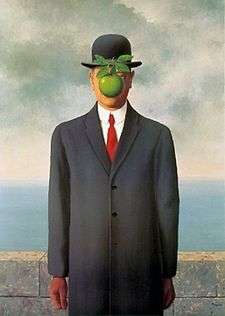The Son of Man
| The Son of Man | |
|---|---|
 | |
| Artist | René Magritte |
| Year | 1964 |
| Medium | Oil on canvas |
| Dimensions | 116 cm × 89 cm (45.67 in × 35 in) |
| Location | Private collection |
The Son of Man (French: Le fils de l'homme) is a 1964 painting by the Belgian surrealist painter René Magritte.
Magritte painted it as a self-portrait. The painting consists of a man in an overcoat and a bowler hat standing in front of a low wall, beyond which is the sea and a cloudy sky. The man's face is largely obscured by a hovering green apple. However, the man's eyes can be seen peeking over the edge of the apple. Another subtle feature is that the man's left arm appears to bend backwards at the elbow.
About the painting, Magritte said:
At least it hides the face partly well, so you have the apparent face, the apple, hiding the visible but hidden, the face of the person. It's something that happens constantly. Everything we see hides another thing, we always want to see what is hidden by what we see. There is an interest in that which is hidden and which the visible does not show us. This interest can take the form of a quite intense feeling, a sort of conflict, one might say, between the visible that is hidden and the visible that is present.[1]
Similar paintings
The Son of Man resembles two other Magritte paintings - both called The Great War (La Grande Guerre) - with similar imagery. One features a person standing in front of a wall overlooking the sea (as in The Son of Man), but it is a woman holding an umbrella, her face covered by flowers. The other is a variation on The Son of Man which represents only the upper torso and head of the bowler hatted man, with the apple completely hiding his face. There is also Man in the Bowler Hat, a similar painting where the man's face is obscured by a bird rather than an apple.
In popular culture
In Gary Braunbeck's novel Keepers, the antagonist figures (the "Keepers" of the title) resemble the nattily-dressed, bowler-hatted figures of Magritte's painting. Also, in the opening scene of the book, the reference is directly made and explained to this resemblance because of an apple-scented car air freshener printed with the image of the painting hanging in the protagonist's car.
In Lev Grossman's 2009 novel The Magicians the antagonist is a man wearing a suit, with his face obscured by a leafed branch suspended in midair.
In Jimmy Liao's illustrated book The Starry Starry Night, the protagonist girl, with the painting illustrated behind her, imitates the painting to express her protest against her parents' long term fighting.[2]
In 1970, Norman Rockwell did a playful homage to The Son of Man as a 330 by 440 mm (13 by 17.5 in) oil painting entitled Mr. Apple[3] in which a man's head is replaced, rather than hidden, by a red apple.
The music video to "Astral Traveller" by the band Yes features a similarly dressed man walking away from the camera throughout the video. He turns to the camera at the end of the video to reveal a large picture of a green apple floating in front of his face.
The painting appears in Alejandro Jodorowsky's film The Holy Mountain, on a wall in the house of Jupiter.[4]
A parody of the painting, with Bart behind the floating apple, can be seen briefly at the start of The Simpsons episode "Treehouse of Horror IV".[5]
The set design, costumes, and promotional poster for the 1992 movie Toys reflect the painting's style.
The painting appears briefly on the video for Michael Jackson and Janet Jackson's song "Scream" (1995), on the “Gallery” section.[6]
The painting appears several times in the 1999 version of The Thomas Crown Affair, especially in the final robbery scenes when men wearing bowler hats and trench coats carry briefcases throughout the museum to cover Crown's movements and confuse the security team.[7]
It is referenced in the 2006 film Stranger Than Fiction.
In the film Mr Magorium's Wonder Emporium (2007), the painting is seen hanging on the wall half finished; at the end of the film Mr Magorium is seen to be painting the rest of it.
This painting also shows up at the end of the film Bronson (2008). British prisoner Charlie Bronson takes a hostage and turns him into this particular portrait.[8]
The cover of the book Rubies in the Orchard: How to Uncover the Hidden Gems in Your Business (2009) has a version of the painting, with a pomegranate.
In the movie 500 Days of Summer (2009), the bowler hat and green apple can be seen in Summer's apartment.
During his performance in the 2012 semi-final of UK talent show The Voice, judge (and the Script frontman) Danny O'Donoghue reenacted the scene depicted in the painting, donning the distinctive hat and clothing, with a model of the apple suspended in front of his face.
A parody painting can be found in Underground Cabins in Terraria.
A similar image, substituting a Georgia peach for the apple, was used in posters to promote the television show Atlanta.
References
- ↑ In a radio interview with Jean Neyens (1965), cited in Torczyner, Magritte: Ideas and Images, trans. Richard Millen (New York: Harry N. Abrams), p.172.
- ↑ http://design-cu.jp/iasdr2013/papers/1711-1b.pdf
- ↑ "Mr Apple by Norman Rockwell brings $33,722 in online auction".
- ↑ "Holy Mountain Screen Capture". Holy Mountain. Twitter.
- ↑ El Arte la Vida Cotidiana Simpsons y Clases. Lacoctelerera.net. May 2, 2011.
- ↑ "Who was Rene Magritte? - René Magritte". Retrieved 1 August 2016.
- ↑ IMDb: The Thomas Crown Affair (1999): Trivia
- ↑ "Bronson Review". Pajiba.com. Retrieved 2016-09-28.